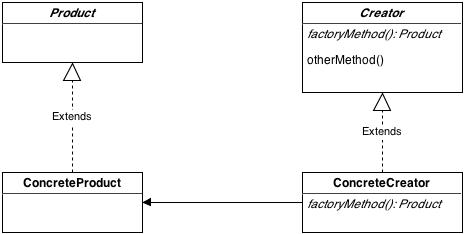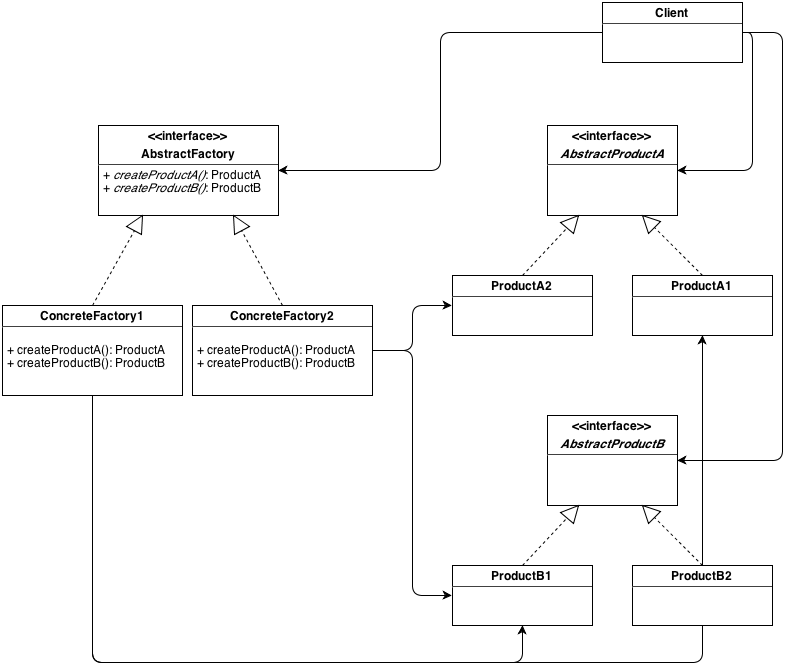Factory pattern
In a Nutshell
- An abstract factory method isolates the client from knowing what class is actually created.
- New operator means directly instantiating an object so direct dependency on a concrete class.
- Code is not close to modification.
- Interface and abstract class imply decoupling code from the actual object. If code is written to an interface it will work with any new class implementing that interface through polymorphism.
- Design principle. Dependency Inversion Principle.
Factory Types
- All factory pattern.
- Encapsulate object creation.
- Promote coding to abstraction reducing dependency on concrete classes and improving loose coupling.
- Client depends on interfaces removing direct object instantiation.
- Hide object construction details from the client.
- Simple factory.
- Not a proper design pattern, but more a programming idiom.
- A simple way to decouple a client from concrete classes.
- Usually a factory class provides a static method to construct an object.
- Factory method.
- Is abstract and protected so defers the instantiation to its subclasses.
- Relies on inheritance that is object creation is delegated to the subclasses which implement the abstract factory method able to create objects.
- Design principle. Dependency Inversion Principle.
- Abstract factory.
- Class whose interface is mostly made of abstract methods.
- Creates a family of related objects without depending on concrete classes.
- relies on object composition that is object creation is implemented in methods exposed in the abstract factory class interface.
Simple Factory
-
Definition. It is not a proper design pattern, but more a programming idiom.
-
Class diagram.
-
Simple factory in action.
- The factory class is responsible to create different concrete products hiding construction details from the client.
- Construction details are in a centralized place, easy to maintain.
- The client is aware only about the product interface and not anymore tightly coupled to its concrete instantiation.
- The factory class encapsulate object creation, not flexible and the creation of new products oblige to modify the class. A class should be closed to modification but open for extensions.
Example
Suppose a car manufacturer which has to build different models of cars but should not be aware of all the production details for each model. Better to use a factory that knows all the details for each model.
public class CarManufacturer {
private CarFactory carFactory;
public CarManufacturer(CarFactory factory) {
this.carFactory = factory;
}
public AbstractCar buildCar(String model) {
AbstractCar car = this.carFactory.createCarInstance(model);
Validate.notNull(car, "Model " + model + " is not available for the build.");
car.assemble();
car.paint();
car.mountWheels();
car.test();
return car;
}
}
The factory knows, according to the model, which concrete class should be instantiated and returned. CarManufacturer HAS-A factory instance and the buildCar method returns an abstract car, so that programming to interfaces allow to return multiple object types.
public class CarFactory {
public static final String A_CLASS = "a-class";
public static final String B_CLASS = "b-class";
public AbstractCar createCarInstance(String model) {
if (model.equalsIgnoreCase(A_CLASS)) {
return new ClassA();
} else if (model.equalsIgnoreCase(B_CLASS)) {
return new ClassB();
}
return null;
}
}
Finally the test class shows how
- implementation details of each model are hidden to the client,
- different factory instances could be passed to the car manufacturer at runtime,
- client is not aware of the concrete object type returned by the factory, but just knows the interface implemented.
public class CarManufacturerTest { private CarManufacturer carManufacturer; @Before public void setUp() { carManufacturer = new CarManufacturer(new CarFactory()); } @Test public void testBuildCarExistingModelClassA() throws Exception { AbstractCar car = carManufacturer.buildCar("a-class"); assertCarBuilt(car); } @Test public void testBuildCarExistingModelClassB() throws Exception { AbstractCar car = carManufacturer.buildCar("b-class"); assertCarBuilt(car); } private void assertCarBuilt(AbstractCar car) throws Exception { assertTrue(car.isAssembled()); assertTrue(car.isPainted()); assertTrue(car.isWheelsMounted()); assertTrue(car.isTested()); } @Rule public ExpectedException thrown = ExpectedException.none(); @Test public void testBuildCarNotExistingModel() throws Exception { thrown.expect(IllegalArgumentException.class); thrown.expectMessage("Model c-class is not available for the build."); AbstractCar car = carManufacturer.buildCar("c-class"); } }
Factory Method
-
Definition. Defines a method interface to create an object and lets subclasses decide which class should be instantiated. Thus the instantiation of the concrete class is deferred to subclasses.
-
Design principle. The dependency inversion principle.
-
Class diagram.

- Factory method in action.
- With respect to the simple factory, the factory method gets rid of the external factory class and localize the making activity in the client class which is then abstract.
- The creation activity is concentrated into a method which acts as a factory.
- Parallel class hierarchies, both the creator and the product hierarchy start from an abstract class.
- Each class extending the abstract one, the client, is called creator class and many of them could be defined.
- The product class is abstract as well, so many product classes could be available.
- Subclasses decide which implementation will be used, so more flexibility and products can vary.
Example
Get rid of the external factory and defines within the client class an abstract method which acts as a factory. The advantage of this design is infinite extension of the class to add new models without changing the factory.
public abstract class AbstractCarManufacturer {
public AbstractCarManufacturer() { }
public final AbstractCar buildCar(final String model) {
AbstractCar car = createCar(model);
Validate.notNull(car, "Model " + model + " is not available for the build.");
car.assemble();
car.paint();
car.mountWheels();
car.test();
return car;
}
protected abstract AbstractCar createCar(final String model);
}
Now the concrete client class implements the factory method and many clients can be defined to create different models.
public class FamilyCarManufacturer extends AbstractCarManufacturer {
public static final String C_CLASS = "c-class";
public static final String E_CLASS = "e-class";
@Override
public AbstractCar createCar(final String model) {
if (model.equalsIgnoreCase(C_CLASS)) {
return new ClassC();
} else if (model.equalsIgnoreCase(E_CLASS)) {
return new ClassE();
}
return null;
}
}
Another manufacturer able to created different kinds of models.
public class SportCarManufacturer extends AbstractCarManufacturer {
public static final String SLK_CLASS = "slk-class";
public static final String SLR_CLASS = "slr-class";
@Override
public AbstractCar createCar(final String model) {
if (model.equalsIgnoreCase(SLK_CLASS)) {
return new ClassA();
} else if (model.equalsIgnoreCase(SLR_CLASS)) {
return new ClassB();
}
return null;
}
}
Abstract Factory Method
- Definition. Provide and interface for creating families of related or dependent objects without specifying their concrete classes.
- Class diagram.

- Class diagram explained.
- The
Clientdefines anAbstractFactoryvariable and the actual factory will be resolved at runtime. - The
AbstractFactorydefines an interface. - Each
ConcreteFactoryrepresents a family of products and implements the method defined in the abstract interface.ConcreteFactory2for instance produces the set of products represented byProductA2andProductB2. - The product family is represented by the two interfaces
AbstractProductAandAbstractProductB.
- The
- Factory method in action.
- The job of an Abstract Factory is to define an interface for creating a set of products through a set of methods.
- Each product method in an interface is responsible to create a product.
- Subclasses of the Abstract Factory provides the implementations.
- Factory Methods are a natural way to implement the product methods in the abstract factories.
- Comparison.
- Abstract factory creates a family or set of products.
- Method factory creates a single product.